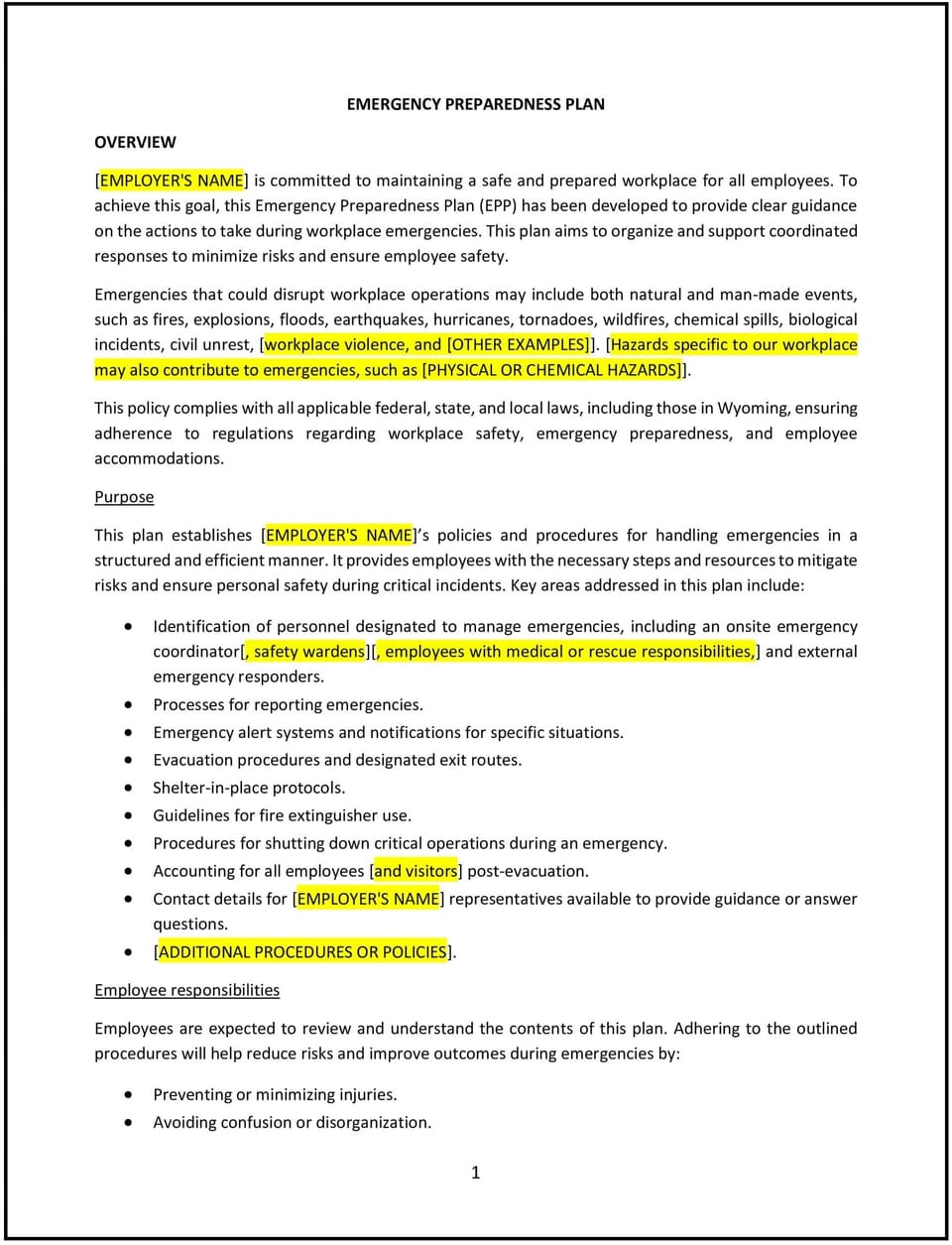Emergency preparedness policy (Wyoming): Free template

Emergency preparedness policy (Wyoming)
In Wyoming, an emergency preparedness policy helps businesses create a structured approach to responding to emergencies such as natural disasters, workplace accidents, or public health crises. This policy is especially important given Wyoming’s unique challenges, including severe weather, rural environments, and industry-specific hazards.
This policy outlines procedures for planning, training, and responding to emergencies, supporting adherence to state and federal safety regulations while prioritizing employee safety and business continuity.
How to use this emergency preparedness policy (Wyoming)
- Identify potential emergencies: List the types of emergencies relevant to your business, such as snowstorms, wildfires, floods, or hazardous material spills. Tailor the policy to Wyoming’s specific risks.
- Develop an action plan: Include clear steps for responding to each type of emergency, such as evacuation procedures, shelter-in-place instructions, or communication protocols.
- Establish roles and responsibilities: Define the roles of employees, supervisors, and emergency coordinators in implementing the plan and ensuring readiness.
- Provide training and drills: Schedule regular training sessions and practice drills to ensure employees understand the procedures and can respond effectively.
- Support compliance: Align the policy with OSHA requirements, Wyoming workplace safety laws, and industry-specific regulations to support legal and operational standards.
Benefits of using an emergency preparedness policy (Wyoming)
A well-implemented emergency preparedness policy provides numerous benefits for Wyoming businesses:
- Enhances safety: Protects employees, customers, and property during emergencies by establishing clear procedures.
- Supports compliance: Aligns with state and federal safety regulations, reducing liability risks.
- Improves readiness: Ensures employees are prepared to respond effectively, minimizing confusion and delays during critical situations.
- Reduces downtime: Facilitates quicker recovery and continuity of operations after an emergency.
- Addresses local needs: Adapts to Wyoming-specific challenges, such as severe weather or remote work environments.
Tips for using an emergency preparedness policy (Wyoming)
- Tailor for your location: Customize the policy to address risks unique to Wyoming, such as snowstorms or wildlife-related hazards.
- Update regularly: Review and revise the policy to reflect changes in laws, business operations, or local conditions.
- Communicate effectively: Ensure employees are familiar with the policy and know where to access emergency plans and contact information.
- Leverage technology: Use tools like emergency notification systems or safety apps to enhance communication and coordination.
- Collaborate locally: Work with Wyoming emergency services and community organizations to improve planning and response efforts.
Q: What types of emergencies should this policy cover?
A: The policy should address natural disasters (e.g., snowstorms, floods), workplace accidents, public health crises, and any industry-specific risks, such as hazardous material incidents.
Q: How can businesses ensure employees are prepared for emergencies?
A: Regular training, practice drills, and clear communication of procedures help employees respond effectively during emergencies.
Q: What should an emergency action plan include?
A: An action plan should include evacuation routes, communication protocols, emergency contact information, and specific steps for various scenarios.
Q: How does this policy support compliance with Wyoming laws?
A: By aligning with OSHA and Wyoming safety regulations, the policy supports compliance and reduces liability during emergencies.
Q: How does this policy benefit Wyoming businesses?
A: An emergency preparedness policy enhances safety, reduces downtime, and promotes compliance, helping businesses protect their employees and operations in critical situations.
This article contains general legal information and does not contain legal advice. Cobrief is not a law firm or a substitute for an attorney or law firm. The law is complex and changes often. For legal advice, please ask a lawyer.


